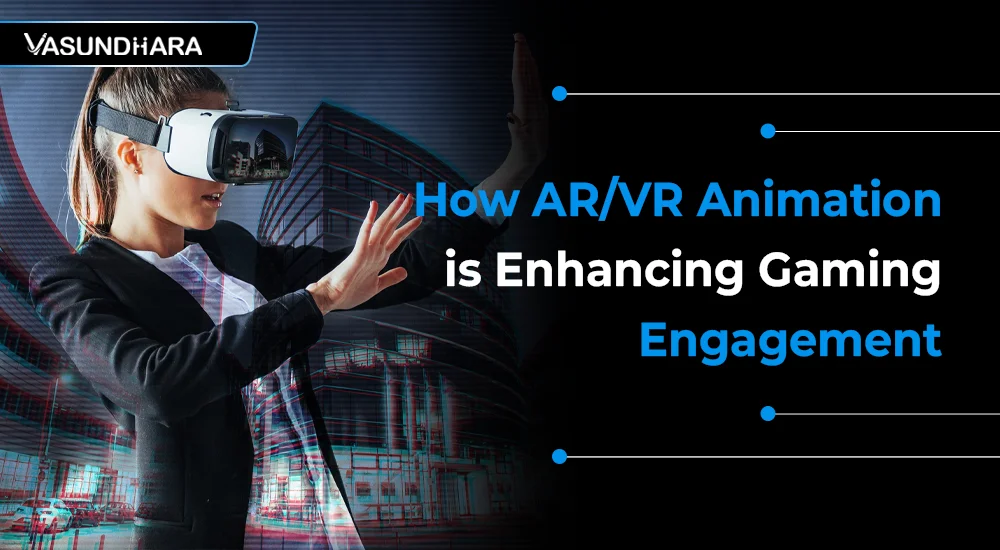Technical developments have had a significant impact on how the user experience has changed in the dynamic gaming business.
The combination of virtual reality (VR) and augmented reality (AR) animation is one such ground-breaking invention that has ushered in a new era of immersive gaming.
Vasundhara Infotech, a mobile game development company, is at the forefront of utilizing AR/VR animation to improve player engagement.
In this blog, we will explore the transformative effects of AR/VR animation on gamification, delving into its applications, benefits, and unparalleled experiences for players.
AR/VR Animation in Gaming: An Overview
Prior to discussing the power of AR/VR animation on gaming engagement, it is essential to have a fundamental understanding of these technologies.
Augmented Reality improves the user's perception of their surroundings by superimposing digital elements onto the physical environment.
Conversely, Virtual Reality engrosses users in an entirely digital milieu, effectively isolating them from the tangible world.
The integration of animation seamlessly into augmented reality (AR) and virtual reality (VR) experiences elevates gaming to an unprecedented level of realism and exhilaration.
The Impact AR/VR on Gaming Engagement
Within the dynamic gaming sector, Augmented Reality (AR) and Virtual Reality (VR) have emerged as transformative technologies, maximizing player retention with stunning animation effects.
The transformative potential of AR/VR in gaming engagement is evident as it provides experiences that surpass conventional limitations.

- Enhanced Immersion and Realism
An important way in which AR/VR animation increases player engagement in a game is by improving realism and immersion.
Traditional gaming engagements frequently require players to engage with a two-dimensional display.
On the contrary, augmented reality (AR) and virtual reality (VR) technologies immerse users in a three-dimensional environment, enabling them to engage with characters and surroundings in unprecedented ways.
Augmented reality (AR) enables gamers to perceive their preferred characters as if they were seamlessly incorporated into their physical environment.
AR/VR animation expands the creative potential for immersive narratives within the realm of video games.
Conventional video games frequently depend on predetermined events and cutscenes to advance the storyline. On the contrary, AR/VR animation transforms narratives into dynamic and interactive experiences.
Consider a hypothetical situation in which players have the ability to impact the course of the narrative through real-time interactions with synthetic characters.
AR seamlessly integrates characters into the player's environment, enabling impromptu interactions that influence the development of the plot.
Virtual reality enables users to investigate the storyline from various vantage points, resulting in an individualized and distinctive narrative encounter.
- Interactive Gameplay Elements
The incorporation of AR/VR animation into interactive gameplay elements enhances the tactile and engaging nature of gaming experiences.
By substituting conventional controllers with intuitive gestures and movements, players are afforded a more natural means of interacting with the virtual environment.
Users may employ voice commands or hand gestures to manipulate objects or control characters in augmented reality.
The direct engagement with the game environment cultivates a perception of agency among players, who believe that their decisions have a direct influence on the game's final result.
Virtual reality surpasses this by completely engrossing participants in an interactive environment.
Individuals have the ability to traverse, approach, and manipulate objects in the virtual environment.
- Multiplayer Experiences Redefined
By bridging the divide between digital and physical social interactions, AR/VR animation is reshaping multiplayer gaming experiences.
Unlike traditional multiplayer games, which frequently require participants to communicate via screens, AR/VR revolutionizes collaboration.
Players can observe the seamless integration of virtual avatars of their peers into the real world using augmented reality.
Engaging in cooperative missions or participating in augmented reality athletics fosters a heightened sense of competition and camaraderie.
Virtual reality (VR) enables users to experience a sense of physical presence alongside others in the same virtual space through its immersive environments.
This sense of presence fosters collaboration and communication, resulting in a gaming experience that is more social and interconnected.
The Integration of AR/VR in Popular Games
Several game developers have embraced AR/VR animation to elevate the gaming experience. Let's explore how some popular games have successfully integrated these technologies
With the introduction of augmented reality (AR) components that let users catch Pokémon in real life, Pokémon GO completely changed mobile gaming.
The secret to the game's success is its ability to smoothly merge the real and virtual worlds, which entices players to investigate their surroundings.
Alyx, an installment in the renowned Half-Life series that utilizes virtual reality, demonstrates the capabilities of VR gaming.
By employing VR technology, the game completely engrosses players in the dystopian world, delivering an unprecedented degree of intricacy and engagement.
By utilizing augmented reality, Minecraft Earth transports the cherished block-building game into the physical world.
Collaborative construction of structures in shared augmented reality spaces by players fosters a sense of community and innovation.
Beat Saber integrates virtual reality technology with rhythm gameplay, transforming players into Jedi-like combatants who slash through blocks to the beat.
Due to its physically engaging and intuitive gameplay, Beat Saber is an exceptional virtual reality experience.
Benefits of AR/VR Animation in Gaming
There are numerous advantages associated with the incorporation of AR/VR animation into gaming, all of which contribute to a more captivating and immersive user experience:
The immersive nature of AR/VR animation captivates players, keeping them deeply engaged in the gaming experience.
The novelty of interacting with virtual elements in the real world adds a layer of excitement and wonder
AR/VR animation allows for more natural and intuitive interactions within the game environment.
Players can use gestures, voice commands, and physical movements to control characters and manipulate objects, fostering a greater sense of agency.
Dynamic storytelling and interactive gameplay elements enable personalized gaming experiences.
Players can shape the narrative based on their decisions, creating a unique journey with each playthrough.
Multiplayer experiences in AR/VR bridge the gap between physical and digital interactions, fostering a sense of social connectivity.
Collaborative missions, competitive sports, and shared AR spaces enhance the communal aspect of gaming.
Game developers are exploring new and innovative ways to design games with the unique capabilities of AR/VR animation.
This has led to the creation of groundbreaking titles that push the boundaries of traditional gaming experiences.
Challenges and Future Developments
AR/VR animation, despite its tremendous potential for the gaming industry, also poses the following obstacles and factors to consider:
Adoption of AR/VR gaming on a large scale is contingent on the affordability and accessibility of compatible hardware.
It is imperative to surmount obstacles pertaining to the expense and availability of devices in order to expand one's target demographic.
Virtual reality experiences, specifically, may present difficulties associated with motion nausea and discomfort.
Continual investigations and progress in software and hardware are directed towards alleviating these concerns and improving user convenience.
Consistently providing a wide selection of superior content is critical for maintaining the appeal of augmented reality and virtual reality gaming.
Ongoing advancements in game design and narrative construction will foster a dynamic and varied ecosystem of experiences.
The creation of AR/VR content necessitates specialized expertise and knowledge.
To ensure a smooth and pleasurable gaming experience, game developers must effectively manage technical limitations and optimize experiences across various devices.
- The process of standardization
For developers, the absence of industry-wide standards for AR/VR development can present obstacles.
By establishing standardized frameworks and guidelines, the development process can be streamlined and interoperability improved.
The Future of Gaming with AR/VR Animation
The prospects for gaming incorporating AR/VR animation are boundless as technology continues to progress.
Anticipated developments and trends that will influence the gaming industry in the coming years are as follows:
As AR/VR hardware becomes more affordable and accessible, it is anticipated that gaming will increasingly adopt these technologies.
The adoption of games into the mainstream will spur innovation and provide game developers with fresh prospects.
Ongoing progressions in AR/VR hardware will effectively rectify existing constraints and augment the overall gaming experience.
Enhanced graphics and processing capabilities, coupled with lighter, more comfortable hardware, will contribute to a more immersive and pleasurable gaming experience.
The innovative potential of AR/VR animation will serve as a catalyst for the development of novel game genres.
Using these technologies in novel ways, developers will investigate methods to expand the limits of conventional gaming experiences.
Conclusion
AR/VR animation is undeniably reshaping the landscape of gaming, offering unprecedented levels of immersion, interactivity, and engagement.
As a leading game development company, Vasundhara Infotech recognizes the transformative potential of these technologies and is at the forefront of creating groundbreaking experiences for players.
The benefits of AR/VR animation, from enhanced storytelling to innovative gameplay elements, are propelling the gaming industry into a new era.
With the integration of these technologies in popular games and the ongoing advancements in hardware and software, the future of gaming looks brighter than ever.
The journey towards a more immersive and interconnected gaming future is an exciting one. Being the best metaverse game development company in India, Vasundhara Infotech is committed to being a key player in this transformative journey.
Get in touch with us. Let's shape the future of gaming together. Request for a FREE quote now!




